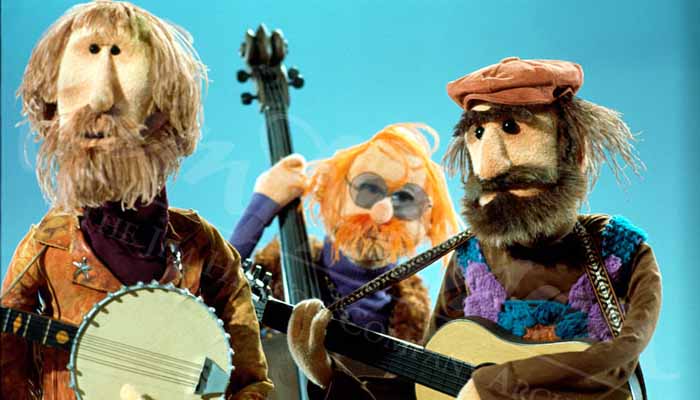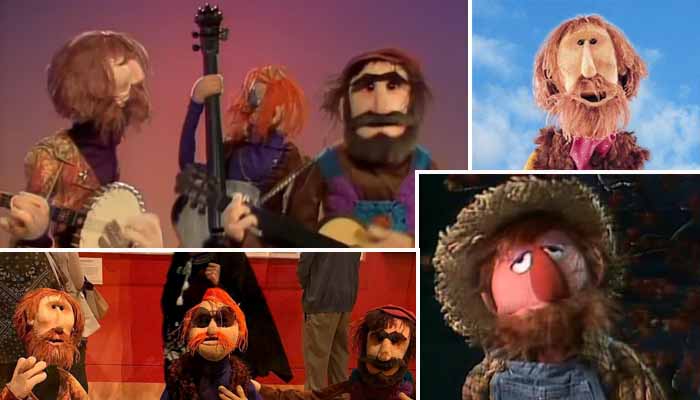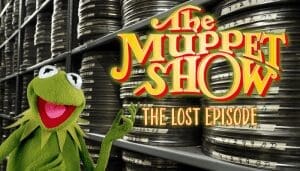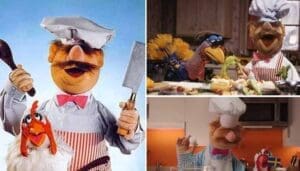Step right up, folks, and prepare for the most sensational, inspirational, celebrational, Muppetational experience! For five glorious seasons between 1976 and 1981, The Muppet Show beamed into living rooms, a whirlwind of sketches, songs, backstage chaos, and unforgettable guest stars. Hosted by the unflappable Kermit the Frog, this variety show was a masterclass in controlled anarchy, blending vaudeville tradition with absurdist humor and a healthy dose of self-aware wit. Amidst the explosions orchestrated by Crazy Harry, the diva antics of Miss Piggy, and the experimental… art of Gonzo, the show also featured a delightful array of musical acts. Beyond the psychedelic rock of Dr. Teeth and the Electric Mayhem, nestled amongst the crooning frogs and operatic pigs, was a charming, down-home musical group known simply as The Country Trio.
But this wasn’t just another band of felt-and-foam performers. The Country Trio held a special secret, an inside joke wrapped in denim and strummed on stringed instruments. They were, in fact, Muppet caricatures of the very geniuses pulling the strings (and providing the voices) behind the scenes: the legendary Jim Henson, Frank Oz, and Jerry Nelson. This delightful bit of self-reference is pure Muppet magic, a nod to the audience that acknowledged the creators within the creation itself. It’s a prime example of the surreal humor and meta-references that became a hallmark of the Muppets, dating back even to their early work and films like The Muppet Movie. The Country Trio wasn’t just performing songs; they were embodying the collaborative spirit and playful self-awareness at the heart of the entire Muppet enterprise. Their existence blurred the lines, transforming the puppeteers into puppets themselves, a tangible representation of the creative energy driving the show.
The choice of a country or folk style for these creator-caricatures adds another layer of charm. While the Muppets embraced all musical genres, featuring guest stars from Elton John to Johnny Cash , presenting Henson, Oz, and Nelson in this folksy format offered a warm, approachable counterpoint to the show’s wilder elements. It perhaps reflected a certain down-to-earth quality, mirroring Kermit’s own banjo-playing inclinations , and provided a comforting musical interlude amidst the beloved Muppet mayhem. They were the show’s heart, made wonderfully, weirdly literal.
Meet the Band: Jim, Frank, and Jerry

So, who exactly were these musical Muppet doppelgängers? Let’s meet the band, member by member, and the giants they represented:
- Jim on Banjo: Leading the trio, often on vocals, was Jim, the banjo player designed as a Muppet version of the ultimate Muppet creator, Jim Henson. With his beard and often gentle demeanor, the resemblance was frequently noted by fans, a clear visual wink to the man behind the frog. Fittingly, Jim Henson himself performed this puppet, lending his own voice and movements to his felt counterpart. This direct link between performer and puppet intensified the meta-commentary, making Jim the most overt representation within the group.
- Frank on Bass: Holding down the low end on the upright bass was Frank, the Muppet stand-in for the incomparable Frank Oz. Performed by Oz himself, Frank the puppet had a simpler, distinct look: a round, orange head, large googly eyes, a slightly open mouth, and usually clad in a brown vest. This less direct caricature, compared to Jim’s, might subtly reflect Oz’s own more reserved public persona relative to Henson’s role as the face of the Muppets. Yet, his presence grounded the Trio, both musically and conceptually, representing another pillar of the core Muppet performing team.
- Jerry on Guitar: Completing the ensemble was Jerry, the guitarist representing the versatile and beloved Jerry Nelson. Nelson, a master puppeteer and vocalist known for bringing characters like Count von Count, Floyd Pepper, Robin the Frog, and Gobo Fraggle to life, performed his own Muppet counterpart. Jerry Nelson’s immense contribution to the Muppet soundscape, particularly his musical talent across various genres, made his inclusion essential. While specific descriptions of the Jerry puppet are scarce, his presence alongside Jim and Frank solidified the Trio as a tribute to these foundational performers.
The creation of these unique puppets fell to designer Bonnie Erickson. In a move that demonstrated the constant innovation happening at Henson Associates, Erickson crafted the Trio’s faces using a new technique: carving them directly out of foam. This method proved highly successful, allowing for expressive yet distinct features, and Erickson would later employ it to create other iconic Muppets, including the grumpy theatre hecklers, Statler and Waldorf. Thus, the Country Trio wasn’t merely a conceptual gag; their physical creation was part of the ongoing artistic and technical evolution that defined the Muppets’ distinctive look and feel. They were an embodiment of the core team, brought to life through the very innovation that characterized their work.
From Como to Kermit: The Trio’s Television Journey
While indelibly linked to The Muppet Show, the Country Trio’s roots actually predate the series. Jim Henson conceived the idea of a musical trio featuring puppet caricatures of himself, Oz, and Nelson for a late-night show pitch to ABC in 1972. Though that specific pitch didn’t materialize into a series, the Trio found other stages.
Their first documented public performance was on The Perry Como Winter Show in late 1972, taped in Los Angeles for a CBS broadcast. Set in a cozy ski lodge environment, the Trio performed the appropriately titled Jim Croce hit, “You Don’t Mess Around with Jim”. This debut established their musical style and the core concept. The following year, they graced The Dick Cavett Show (1973), offering a rendition of the classic folk tune “Mamma Don’t Allow”. They even made an appearance in the second pilot produced for The Muppet Show, titled The Muppet Show: Sex and Violence (1975), signaling Henson’s intent to include them in his variety show concept from early on. This journey from initial concept through various television specials demonstrates Henson’s iterative creative process – testing, refining, and carrying forward beloved characters and concepts across different projects.
When The Muppet Show finally launched, the Country Trio became charming, recurring musical guests, particularly in the early seasons. Their appearances helped solidify the show’s eclectic tone right from the start. Notably, they featured prominently in Episode 105, guest-starring Rita Moreno. This episode holds historical significance as the first one aired in the United States (premiering September 20, 1976), though it was the fifth produced. Choosing this episode, widely regarded by fans as one of the first season’s best , to introduce American audiences to the Muppets meant the Country Trio was part of that crucial first impression. In it, they performed their perhaps most well-known number from the series, the cleverly confusing folk song “To Morrow”. With Jim handling the lead vocals as the perplexed traveler seeking directions, the performance culminated in Frank’s perfectly delivered, deep-voiced deadpan line: “I don’t get it”. Placing this act in the premiere underscored their role as a reliable, endearing part of the Muppet formula.
Later in the first season, they returned in Episode 123, guest-starring Kaye Ballard (aired May 7, 1977). Here, they performed a cover of Roger Miller’s melancholic country song “In the Summertime” (also known as “You Don’t Want My Love”). Once again, Jim took the lead vocal, with Frank providing backup. Their presence in these key early episodes cemented them as part of the show’s foundational fabric.
While their appearances seemed most frequent in the first season, they weren’t entirely absent later. Frank’s final on-screen appearance with the Trio might have been a background spot in Episode 317 (Spike Milligan, 1978). However, Jim and Jerry surfaced again as a duo in Episode 322 (Roy Rogers & Dale Evans, 1978), performing the Western standard “A Four Legged Friend” while perched atop cows, perfectly fitting the episode’s theme. This shift might reflect the increasing demands on the core performers as the show’s complexity grew, with Oz, in particular, juggling iconic characters like Miss Piggy, Fozzie Bear, and Animal , or perhaps it was just a natural evolution of recurring segments within the show’s five-season run.
The Trio’s music also made its way onto record. Jerry Nelson is credited for performing with the Country Trio on the first soundtrack album, The Muppet Show, released in 1977. And in a testament to the flexibility sometimes required in Muppet productions, one source notes a PBS promotional spot where the Jerry puppet was reportedly performed by Richard Hunt, another core Muppeteer.
The Setlist: Songs Sung by the Trio
The Country Trio’s repertoire, though small, was perfectly curated to fit their folksy, slightly humorous persona. Their songs often played on gentle wordplay or carried a familiar, down-home feel, reinforcing their identity within the Muppet musical landscape.
- “You Don’t Mess Around with Jim”: Their debut song on The Perry Como Winter Show (1972) was this Jim Croce classic. The title itself adds a layer of meta-humor, given the Jim puppet representing Jim Henson.
- “Mamma Don’t Allow”: For their Dick Cavett Show appearance (1973), they chose this traditional folk/blues standard about making music despite objections, fitting their slightly rebellious, musician-caricature nature.
- “To Morrow”: Arguably their signature tune from The Muppet Show (Episode 105, Rita Moreno), this song, based on a poem often attributed to Stephen Foster and popularized by various folk and country artists, relies on the humorous confusion between “tomorrow” and the name of a town, “Morrow,” Ohio. Jim’s earnest lead vocal as the confused traveler and Frank’s final punchline made it a memorable comedic piece.
- “In the Summertime (You Don’t Want My Love)”: Performed in Episode 123 (Kaye Ballard), this Roger Miller tune showcased a more melancholic country sound. Its inclusion highlights the show’s engagement with contemporary and classic songwriters. Interestingly, Roger Miller himself would later guest star in Season 3 (Episode 321) and perform his own version of the song , creating a delightful connection between the Muppet cover and the original artist. This sequence demonstrates how Muppet renditions often became beloved versions in their own right, sometimes paving the way for the original artists to appear.
- “A Four Legged Friend”: Performed as a duo by Jim and Jerry in Episode 322 (Roy Rogers & Dale Evans), this song, famously associated with Roy Rogers, was a perfect fit for the guest stars and the Western theme of their segment, performed unconventionally atop cows.
To capture their key performances at a glance:
The Country Trio’s Greatest Hits
| Song Title | Original Artist/Writer | Key Appearance(s) | Notes |
|---|---|---|---|
| “You Don’t Mess Around with Jim” | Jim Croce | Perry Como Winter Show (1972) | Trio’s debut performance. |
| “Mamma Don’t Allow” | Traditional | Dick Cavett Show (1973) | Classic folk tune. |
| “To Morrow” | Stephen Foster / Folk | The Muppet Show Ep 105 (Rita Moreno) | Lead: Jim. Spoken: Frank. Considered their signature TMS song. |
| “In the Summertime (You Don’t Want My Love)” | Roger Miller | The Muppet Show Ep 123 (Kaye Ballard) | Lead: Jim. Roger Miller later performed it on the show (Ep 321). |
| “A Four Legged Friend” | Roy Rogers (Jack Brooks / Harry Warren) | The Muppet Show Ep 322 (Roy Rogers & Dale Evans) | Performed by Jim & Jerry atop cows. |
An Inside Joke with Heart: Why We Love The Country Trio
So why does this relatively minor Muppet act continue to hold such a special place in the hearts of fans? The Country Trio’s appeal is multi-layered. At its core is the delightful meta-humor – the sheer fun of seeing the show’s architects, Henson, Oz, and Nelson, immortalized as these earnest, slightly goofy folk musicians. It was an affectionate, tangible tribute to the collaboration and friendship that formed the bedrock of the Muppets.
Beyond the inside joke, they contributed significantly to the rich tapestry of The Muppet Show‘s variety format. They offered a different flavor of music, a calmer, more traditional sound that provided a gentle counterpoint to the show’s inherent chaos. Their simple designs, brought to life with sincerity by the master performers they represented, exuded a unique charm. Fans often express deep affection for them, recognizing their value beyond just a sight gag.
In retrospect, the Country Trio also serves as a poignant historical marker. They represent that specific, foundational era of The Muppet Show, embodying the original core performing team of Henson, Oz, and Nelson during the show’s peak years. Their appearances capture a snapshot of that particular configuration of talent working together, making them a nostalgic touchstone for those who grew up with the original series.
Ultimately, their enduring appeal lies in that perfect Muppet blend: catchy, well-performed folk and country tunes, gentle humor often derived from the song lyrics or the performance context (like Frank’s deadpan delivery), and the undeniable warmth radiating from the real-life relationships they symbolized. They weren’t the stars, but The Country Trio was pure Muppet heart, strummed on a banjo, bass, and guitar – a beloved, if lesser-known, gem in the Muppet musical crown.



